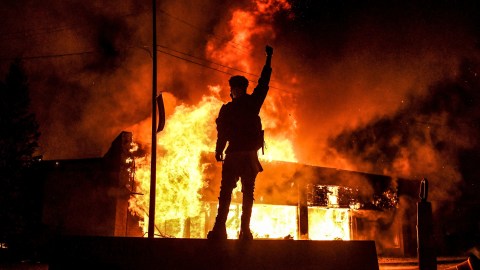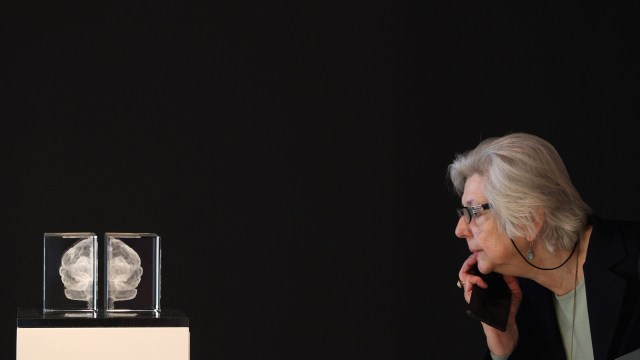Does rioting work? Here are five times it did.

(Photo by CHANDAN KHANNA/AFP via Getty Images)
- We often hear that riots are not an effective means towards social change, but what do the experts say?
- Experts are still working on it, but it is agreed that it is at least occasionally effective.
- We include five cases of when rioting clearly led to desired social change.
The United States has a long history of rioting. Some of these events, such as the Boston Tea Party, are well known and celebrated. Others, such as the Tulsa Race Riots, are rarely discussed and only with a proper level of shame. These days, whenever rioting breaks out, one of the first points made is that “rioting doesn’t work.” However, several experts on the subject disagree with that analysis.
In his recent Jacobin article, Dr. Paul Heideman refers to data that shows how popular support for more policy changes to advance equal rights spiked to new highs following the riots in Ferguson and similar ones in Baltimore in 2014 and 2015. He also points to data showing how the 1992 Los Angeles riots increased support for liberal policies. Darnell Hunt, a professor at UCLA, pointed out to Vox readers that this shift in opinions led to concrete policy changes in Los Angeles. In the same article, Heather Ann Thompson of the University of Michigan explained how the riots of the 1960s lead to the Kerner Commission.
Other experts agree that rioting can lead to desired change, but caution that the effects are not as clear cut as many would like to think they are.
In reference to the then-current riots which lead to the 2011 Revolution in Egypt, Megan McArdle of The Atlantic noted that there are cases where riots work, even if the track record is spotty. Thomas Sugrue, a historian at New York University, told Vox that many social changes were accelerated by rioting, but that they also “cut both ways,” as there is always some unseen consequence that can muddy the waters.
Assistant Princeton professor Omar Wasow, in a study published this month in the American Political Science Review, argues that while peaceful protest caused popular opinion to shift towards equal rights legislation, the riots that followed the death of Martin Luther King caused American voters to turn towards Richard Nixon in the next election –leading to the “tough on crime” policies people are protesting at this moment. This suggests that while riots can lead to change, they can also prompt a backlash strong enough to erode those gains.
Taking these experts’ opinions together, it is clear that rioting can cause change at least some of the time. A basic understanding of American history endorses this view. Here, we will take the opinions of the above experts to heart and consider five times in American history that rioting was able to deliver the change that people demanded.
Of course, there are plenty of examples from outside the United States as well. This list is also far from exhaustive when it comes to the United States.
Re: Do Americans understand the American Revolution?
The Stamp Acts were the first attempt at directly taxing the American Colonies by the British Parliament. Like the later taxes that would directly lead to the American Revolution, these were imposed without the representation of the colonists. The act required that all printed materials in the colonies be on specially printed paper that carried a revenue stamp.
Shortly after the law passed, the protests and riots started. Street protests of unprecedented size broke out from New Hampshire to Georgia. In Boston, an effigy of the appointed tax collector Andrew Oliver, who didn’t know he had been appointed to the role, was beheaded by an angry mob who then threw rocks at his house and raided his wine cellar. A few weeks later, the same group stormed the mansion of the Lieutenant Governor and took everything not bolted down, including the slate roof.
Similar riots broke out in every colony. Ships bringing in the stamped paper were turned back at harbors. Every designated tax collector resigned within eight months of the law’s passage. The act was repealed after only one year of existence and without having raised much money at all.
Groups that had organized to resist the act formed the Sons of Liberty, which would play a large part in the beginnings of the American Revolution.
Democracy: Still the worst kind of government except all the other kinds
In 1660, when the colonial charter of Rhode Island was drawn up, it included an uncontroversial requirement that all voters own property. After all, when they wrote it, most people were farmers who owned their land. Nearly two hundred years later, however, this situation was intolerable. Only 40% of the state’s white male population could vote, and even this group was far more rural than the white male population as a whole.
Given that most other states had near-universal white male suffrage by 1840, the people of Rhode Island tried to peacefully replace the colonial charter with a more liberal state constitution. However, these attempts all failed at the hands of the misaligned state legislature. In 1841, having given up on working within the system, a group of supporters led by Thomas Dorr had a people’s convention that drafted a liberal constitution granting universal white male suffrage, which was supported by considerable margins in a later referendum.
Both Dorr’s supporters and the original government of Rhode Island held elections for governor the next year, with neither party recognizing the other. Predicting trouble, the old state government instituted martial law. Dorr’s supporters later attempted a raid on the Providence Arsenal but were driven back. After the state militia was called out to battle a collection of armed Dorr supporters who gathered for another convention, Dorr dissolved his forces and fled the state.
Shocked by the strength of Dorr’s supporters, the old state legislature passed a new constitution that expanded suffrage even further than the one Dorr suggested. Dorr was arrested, given a harsh sentence, and then released after a public outcry. He is traditionally listed as a governor of Rhode Island in recognition of his popular support.
Immigration Gives Us 2 Options: One Is Fear, the Other Profoundly Saves …
In 1855 as the temperance movement began to pick up steam, it was not uncommon for legislatures to limit which days alcohol could be purchased and who could sell it. In Chicago, under Know-Nothing mayor Levi Boone, the city increased the price of liquor licenses from $50 to $300*. It also reduced their term of validity to three months, down from one year, in an attempt to reduce the number of saloons in the city.
This action had a distinctly anti-immigration tone to it, as the legislation most impacted German and Irish immigrants. They enjoyed a drink on their one day off at saloons in their own, often more impoverished neighborhoods.
Saloon owners ignored the law, and two hundred were quickly arrested. On the day of the first criminal trial related to the law, immigrants swarmed the downtown area. After several arrests, an armed group of German immigrants marched on the area from the North Side to rescue the prisoners. The bridges across the Chicago River were swung to prevent crossing and allowing the police time to gather. When the bridges were turned back, the immigrants charged and were fired upon, killing one.
As a result of the rioting, the licensing fee went back down to $50, residents of Chicago started to pay attention to who was running the city, and the Sunday law went back to infrequent enforcement. Those charged with violating the law were not released, but the rioters got off scot-free.
What Hope Actually Meant to Martin Luther King Jr.
Two riots separated by less than a year, which led to the passage of the Civil Rights Act of 1968.
Sparked by a police raid on a bar hosting a party to celebrate the return of two GI’s from Vietnam, the Detroit riot soon spread all over the city. The national guard was quickly called in by Governor Romney. However, the guardsmen’s lack of professionalism and experience led to several deaths and did little to stop the rioting. So many people were arrested that the Windsor, Canada police stepped in to help process fingerprints. Several instances of incredible police brutality took place. This did nothing to help restore order- nearly 500 fires blazed on the second day of rioting.
Around midnight on the third day, President Johnson sent in federal troops. While the army proved more effective than the National Guard, it took another 48 hours for the riots to end. Dozens of people died, hundreds were wounded, more than a thousand buildings burned, several thousand people were arrested, and the images of tanks in the streets of a burning American city graced screens worldwide.
While the riots were still ongoing, President Johnson formed the Kerner Commission to investigate the causes of the riots and suggest solutions. Their report found that African Americans did, in fact, endure problems related to what we would now call “systemic racism.” It called for a variety of policy changes, including fair housing laws, job programs, and more public housing. As has been a theme in the American history of addressing racism, Johnson and Congress proceeded to ignore these suggestions.
One month after the release of that report, when Rev. Dr. Martin Luther King Jr. was struck down, riots broke out in more than 100 American cities. President Lyndon Johnson pressured Congress to act. With the sound of rioting audible from within their smoke-filled meeting rooms, Congress found the votes to pass the previously stalled Civil Rights Act in six days.
Forty Years After Stonewall
The dawn of the LGTBQ+ rights movement, Stonewall was a standard police raid on yet another gay bar that went in a very different direction.
At 1:20 on the morning of June 28, 1968, the police knocked down the door of a mafia owned gay bar in the Village without running water to clean glasses with. The patrons of the bar refused to cooperate with police demands for identification and verification of what sex they were, resulting in the decision to arrest them all. A crowd began to form outside the bar, which dramatically outnumbered the police.
After witnessing the police strike an unknown woman* with a baton, the crowd attacked the police vans, slashing the tires and helping the arrested escape. The police barricaded themselves inside the bar, which was then besieged by the assemblage with an impromptu battering ram. The officers who brought the paddy wagons fled.
Police reinforcements arrived, but the situation only deteriorated from there. Nightstick wielding officers attacked a singing kickline, police were chased down the street by the crowd, and the Stonewall Inn was laid waste. Rioting continued over the next few days before dissipating.
Unlike the other riots on this list, the immediate effects of Stonewall were oriented more towards psychological and activist outcomes rather than changes in the legal system. Raids on gay bars continued, but gay newspapers, organizations, and activist groups sprang up like flowers in the spring. Two years to the day of the riot, the first Pride parades took place. Gay rights activists Randy Wicker and Frank Kameny, who were both initially embarrassed by the riot, went on to claim that there was a definite psychological effect caused by the event, which “stirred an unexpected spirit among many homosexuals.”
The results of that psychological change and the fruits of that post-riot organization are evident today in the robustness of the LGBTQ+ movement and its successes.
* Today, this would be around eight thousand dollars.
* Ideas as to who this person was vary and a definitive answer remains elusive.





